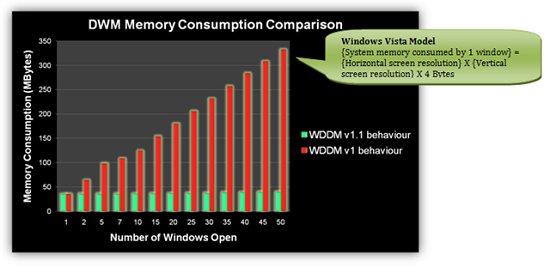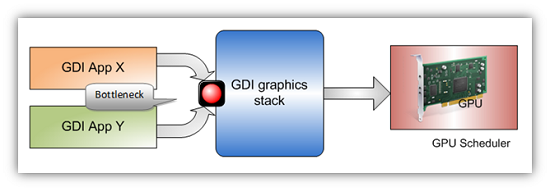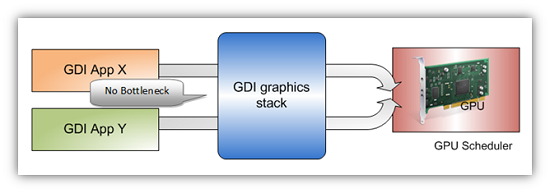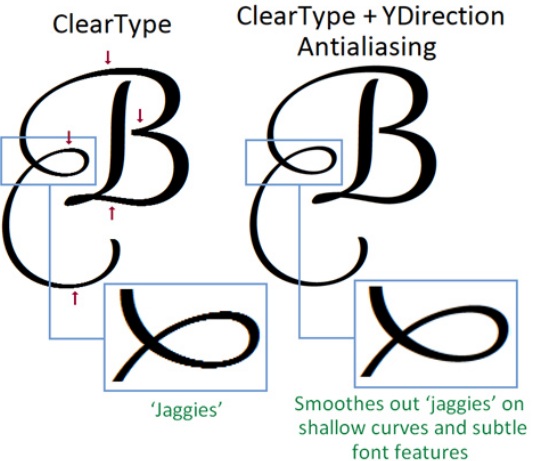Windows 7: Release Candidate 1 Preview
by Ryan Smith and Gary Key on May 5, 2009 11:00 PM EST- Posted in
- Systems
Getting Dirtier: Graphics
With the majority of the under the hood work focusing on graphics, there’s a lot to cover, so let’s get started.
Although it is being released for Vista too, Windows 7 marks the official introduction of Direct3D 11. As a superset of Direct3D 10.1, Direct3D 11 adds support for tessellation, multi-threaded rendering, and GPGPU abilities via the Compute Shader. We’ve already covered a great deal on Direct3D 11, so please see our introduction article on it for more details.
Next up we have the Windows Display Driver Model 1.1, which in turn is the lynchpin for several other graphics related features. WDDM 1.1 itself is not particularly impressive, but it’s what it allows that is. For all practical purposes, all we need to know about WDDM 1.1 is that it’s a minor revision of WDDM that requires DX10-class hardware (rather than DX9-class on WDDM 1.0) and as such allows the operating system additional features.
So what can you do with WDDM 1.1? For starters, you can significantly curtail memory usage for the Desktop Window Manager when it’s enabled for Aero. With the DWM enabled, every window is an uncompressed texture in order for it to be processed by the video card. The problem with this is that when it comes to windows drawn with Microsoft’s older GDI/GDI+ technology, the DWM needs two copies of the data – one on the video card for rendering purposes, and another copy in main memory for the DWM to work on. Because these textures are uncompressed, the amount of memory a single window takes is the product of its size, specifically: Width X Height x 4 bytes of color information.

Image courtesy Microsoft
Furthermore while a single window may not be too bad, additional windows compound this problem. In this case Microsoft lists the memory consumption of 15 1600x1200 windows at 109MB. This isn’t a problem for the video card, which has plenty of memory dedicated for the task, but for system memory it’s another issue since it’s eating into memory that could be used for something else. With WDDM 1.1, Microsoft has been able remove the copy of the texture from system memory and operate solely on the contents in video memory. As a result the memory consumption of Windows is immediately reduced, potentially by hundreds of megabytes.
What makes this even more interesting is how this was accomplished. With WinXP, GDI+ was partially accelerated, but this ability was lost to little fanfare when the DWM was introduced for Vista and thereby made GDI+ acceleration impossible, pushing all GDI work back to the CPU. This in turn is responsible for the need for a local copy of GDI and GDI+ windows and the increased memory usage of Vista, as reading data back from the video memory for the CPU to work on is too slow to be practical. The solution as it turns out is that by reintroducing GDI acceleration, the amount of read-backs can be minimized to the point that a local copy of the texture is no longer necessary. Now GDI isn’t completely accelerated, only the most common calls are, but this is enough that when the least common calls trigger a read-back, the performance hit is negligible.
This is one of the bigger changes in Windows to get memory consumption under control. The problem was particularly bad on netbooks and other systems with integrated graphics, as the video memory is the system memory, resulting in two copies of the texture being in the system memory (something such a machine probably has little of in the first place). The fact that this requires a DX10-class card with a WDDM 1.1 driver needs to be reinforced however – this won’t be of any help for systems with lesser GPUs, such as Atoms paired with the 945G chipset, as the GMA 950 GPU on that chipset is only DX9-class. NVIDIA, no doubt, is grinning from ear to ear on this one.
The other big trick as a result of WDDM 1.1 is that support for heterogeneous display drivers has returned. With WDDM 1.0 and its homogenous driver requirement, computers were limited to using video cards that would work with a single driver – in turn limiting a computer to video cards from a single vendor. With heterogeneous driver support, computers are once again free to use non-matching video cards, so long as they have a WDDM 1.1 driver. Besides that, this also is a boon for GPGPU use, as GPUs continue to interface with Windows via WDDM regardless of whether they’re actually displaying something or not. For example, this would allow NVIDIA to sell video cards as GPGPU processors to ATI owners, and vice versa.
WDDM 1.1 also brings a few lesser features to Windows 7. The DWM can now run in DX10 mode and new controls are introduced for aspect ratio scaling and controlling monitor modes.
Moving on from WDDM 1.1, Microsoft has also introduced some changes to GDI that do not require new display drivers. Along with requiring a local copy of window textures, the GDI stack was locked so that only a single GDI application could access it at a time. The GDI stack has been rebuilt so that the lock is more or less removed. Multiple GDI applications can now issue commands to it at the same time, and this is all pushed off to the video card to be its problem.


Images courtesy Microsoft
Unfortunately Microsoft has not provided us with any examples of this in action, so we’re not sure just what the real-world benefit is.
Next up, more DRM. Although we’re not entirely sure what has been changed, Microsoft has told us that they have made some changes with respect to DRM and GPU acceleration. Previously some applications playing DRMed content needed to switch to overlay mode to ensure the content was protected the entire way through. Likely this is a new low-level API for such functionality; Microsoft’s notes mention a standardized API for CPU to GPU encryption.
Last but not least, we have two new high-level graphics APIs in Windows 7. The first is Direct2D, the successor to GDI and a replacement for some Direct3D functionality. Like Direct3D, Direct2D is a fully hardware accelerated API, but it’s only for 2D operations. When Microsoft deprecated DirectDraw, the intention was for developers to use Direct3D for all of their 2D needs, but this never quite worked out as well as they intended. So now we have Direct2D, which gives developers a dedicated 2D API once again, along with a clear replacement for GDI.
Also introduced is an API specifically for text, DirectWrite. Where Direct2D works on 2D primitives, DirectWrite is responsible for the hardware anti-aliasing of text. NVIDIA sent us some documentation on the matter, and apparently the anti-aliasing method used (YDirection Antialiasing) can provide even better smoothing than ClearType can alone. It does not sound like any Windows components are currently using DirectWrite however.

Hardware font anti-aliasing in action. Image courtesy NVIDIA
We should note that while the “Direct” name implies these APIs are a part of DirectX, all of the material we have on the matter only mentions Windows 7. They may not be part of DirectX, in which case they would not be added to Vista as part of DirectX 11.










121 Comments
View All Comments
Jman13 - Friday, May 8, 2009 - link
I installed the x64 version of RC1 last night. Painless install, and VERY fast. Much faster than my XP install. I'm talking about actual usage of the computer, not the install (though that was fast too). I skipped Vista, but Win7 really looks to be a very good OS. Some of the usability features in Win7 are really nice (half screen docking to the side, for instance. I'm now using RC1 as my main OS, and likely will stay that way until the actual release, where I will finally upgrade from XP.I'm very pleased.
Jackattak - Friday, May 8, 2009 - link
Mine also went completely as planned last night. I loaded it onto my Dell XPS420 on a spare 160GB HD I had in there.Painless, flawless, and runs like a dream (as does Vista, so that was to be expected).
Loaded the 185 drivers from nVidia for my 8800GT 512MB, installed Left 4 Dead (and Steam), and played for an hour without any issues at all.
Lovin' the new UI. Hopefully it gets even cooler when the retail release comes out, but I doubt they'll make any drastic changes by then as there would be lots of RC users taken aback.
Great work so far, M$. Keep it up.
~Jackattak
Grandpa - Friday, May 8, 2009 - link
I absolutely hate the menu in Win 7. 3 to 4 clicks to open a program that would only take 1 click in XP or Vista. Also, in Control Panel, there is no option for the Classic look there. I don't see any performance boost over Vista whatsoever. There just isn't a good reason to pay good money for this. Linux is a much better value.Jman13 - Friday, May 8, 2009 - link
There's an option for the classic look. Just change the view to large or small icons in the upper right corner.Grandpa - Monday, May 11, 2009 - link
It isn't just the look. When you hover over the folder you want to open, it doesn't open unless you click ( even though the option for that to happen is checked ).PS: I have used Linux. It's just a little difficult to play the games I like playing with it.
B3an - Friday, May 8, 2009 - link
Oh look a linux fanboy bashing Win7. Like your've even fucking tried it.HellcatM - Thursday, May 7, 2009 - link
I thought Vista was ok, I liked the start menu and it just bets better with Windows 7. I find things just as easy as well, if not easier because I can just type in the search.I think setting up a network, wireless and a printer is much easier too. I haven't tested home network because I don't have two computers computers to test it on. I like the idea though.
The UI I like, the launch bar is good. I'm just wondering if Microsoft is going to do a UI change for the gold release. My thought is they know that since they did an open beta they way they did where anyone can use it, that people at Apple are going to be looking at it really closely and they'll make changes to Mac OS. With a UI change it'll give a curveball to Apple. Maybe MS has a major jaw dropping UI change. I just don't think their going to take a chance that Apple is going to test Win 7 and not make changes to their own. I know if I were Apple I would.
I think Windows 7 is ready now. Its a strong OS and I haven't had any major problems. Its quick, has some nice features, and it looks nice.
Jackattak - Thursday, May 7, 2009 - link
Loved it. I have downloaded both the x64 and x86 versions and will be installing them tonight.My one comment on OS brands (I use all of them for one thing or another at work and at home):
When Apple has a serious market share in the personal computing world and can truly develop an operating system for use on hardware from thousands (millions?) of different manufacturers, THEN (and only then) Microsoft will have a problem. Until then, Microsoft will continue to rule the planet, complainers and whiners be damned.
Apple has no serious market share in the home or business.
Linux is for computer professionals and tinkerers.
Microsoft is for the other 97% of the world.
:D
~Jackattak
DrRap - Thursday, May 7, 2009 - link
windows has left the building guyshttp://www.youtube.com/watch?v=wVM32aEABGY&fea...">http://www.youtube.com/watch?v=wVM32aEABGY&fea...
Techno Pride - Thursday, May 7, 2009 - link
I don't get it. It's just an OS, a tool. Does it really matter what brand of hammer you use?Shouldn't it matter more whether any tangible results are produced using whatever tools are available?